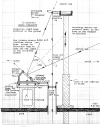




(See more at http://sites.netscape.net/k3halpha/halpha2.html)
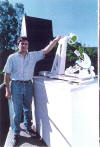
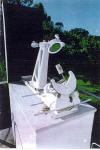
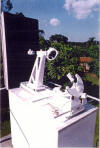
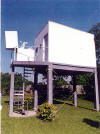
The Beeker ceolostat from various angles (south is to the left, leftmost pictures are opened, right closed)
You should use long focal length optics for the spectroscope in order to stretch out lengthwise the solar spectrum. About 60mm by 900mm focal length or 60mm diameter by 1000mm focal length will be excellent, not cost too much from Surplus Shed, which now is advertising in Sky and Telescope, look in the back ad pages.
And use a 45% theoretical resolution diffraction grating from Edmund, cost about 90 dollars approx, 1800 gratings/mm will be best, 25x25mm ruled area, further stretching lengthwise the solar spectrum. The result will be about 8A/mm, passband about 0.8A wide. The latter is ok for prom but contrast average for the solar disk in H alpha light. For excellent contrast use a 90% theoretical resolution grating, cost about $350.
The telescope can be about 80 by 1300mm or related achromat, also use a long negative focal length Barlow to give about 2X, making the effective focal length about 9 feet focal length .(2.7 meters) for a 25mm diameter sun image on the entrance slit. The sideways movement of the slits is called the Arcetri (Are-che-tree) synthesizer. The 60-foot solar tower in Florence, Italy, uses a similar motion for the slits for spectroheliograms of the solar disk.
The sideways movement should not be too much, say about 12mm back and forth, this better guarantees that the synthesizer will work ok. If 12mm is good, then you can try about 18mm. The idea is to go step by step just to be use all is mechanical and optical working. The two 60 by 1000mm focal length achromats ideally should be the same focal length . If not, you can use a glass shim to make up for the difference. Assume one achromat is 990mm focal length and the other is 995mm focal length Then you have a difference of 5 mm. So get a good quality optical window about 15mm thick. Can use two pieces of glass cemented together. Surface flatness about one to two waves is good, not so expensive. The glass thickness will shift forward the solar image by one third of the thickness. So in this case, about 5mm shift forward. Result will be the two achromat will be almost exactly the same focal length For the heliostat, use a diagonal about 60mm minor axis, Pyrex, about 1/8 wave flat will be good enough.
Total costs will depend upon the grating used. Average costs will be about $400. You do not have to copy the prototype by Fred as published in Sky and Tele in 1969. There are many possible designs. The main thought is to keep the focal lengths long, and test the optics to be sure that they are 1/8 wave corrected for spherical aberration at infinity focus. A Ronchi screen from Willman-Bell is low cost, 50x50mm size, about 100 gr/inch is good, about $4.Mount on piece of optical window glass, about 99% flat is ok. A glass Ronchi screen from Edmund is about $25.
Hello All,
I recently received a number of old Sky and Telescopes from the 60's
and early 70's to further my collection. While going through them I found
and interesting article in Oct. 1971, " A Compact Prize-winning
Spectrohelioscope". The article discusses the construction of a simple, low
cost SHS made from two binocular lens and a 600 lines/mm transmission
grating. The optics are layout in Arcetri design and uses a 60mm refractor
to form the image of the Sun on the entrance slit. The movement of slits is
with a toy motor and whole assembly is made out of what looks to be 1/4"
plywood. The unit was build by a 10th grade high school student. A quick
check of Surplus Shed shows that similar lens cost about $7 each and
grating is $15 so one should be able to construct similar unit for around
$50. The linear dispersion is about 85 A/mm so with a 0.06mm (0.002 inches)
slits width, one would get a 5 A bandpass which would be fine for viewing
prominence and the unit could also be tuned to the Ca-K line, for observing
there. A unit like this would allow one to enter into H-alpha viewing which
out a large out lay of money and also give one experience in building a
SHS that can be used in constructing a larger and higher resolution
instrument. I have already started to build one to see what it will show.
Best Regards,
Dave